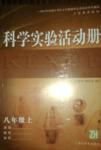题目内容
Site will tell us why she feels so strongly that each of us has a role______ in making the earth a better place to live.
A. to have played
B. to play
C. to be played
D. to be playing
| B |

 科学实验活动册系列答案
科学实验活动册系列答案The Book of Life
So far, scientists have named about 1.8 million living species(物种), and that’s just a small number of what probably exists on Earth. With so many plants, animals, and other living things coveting the planet, it can be tough to figure out what type of grass is growing by the roadside or what kind of bird just flew by.
A soon-to-be-started Web site might help. An international team of researchers has announced the creation of Web-based Encyclopedia(百科全书) of Life ( EoL). The project aims to list every species on Earth in a single, easy-to-use reference guide.
To get the encyclopedia started, the creators will use information from scientific databases (数据库) that already exist. And eventually, in special sections of the site, non-scientists with specialized knowledge will come to help. Bird-watchers, for example, will be able to input what birds they’ve seen and where. To make sure the encyclopedia is accurate, scientists will review much of the information added to it.
As the EoL develops, you might find it useful for school projects. The site will feature (以……为特色) special pages for kids who are studying ecosystems in their neighborhoods. Another convenient feature of the EoL is that you’ll be able to pick the level of detail you want to see to match your interests, age, and knowledge.
It now takes years for scientists to collect all the data they need to describe and analyze species. The creators of the Encyclopedia of Life hope that their new tool will speed up that process.
【小题1】The Web-based EoL aims to__________ .
| A.find out what covers the earth |
| B.list all living things on Earth |
| C.work out the number of birds |
| D.save the existing plants |
| A.it is run by school students |
| B.it focuses on different types of grass |
| C.it provides different levels of information |
| D.it allows non-scientists to review its data |
| A.analyzing species | B.creating a new tool |
| C.collecting data | D.describing species |